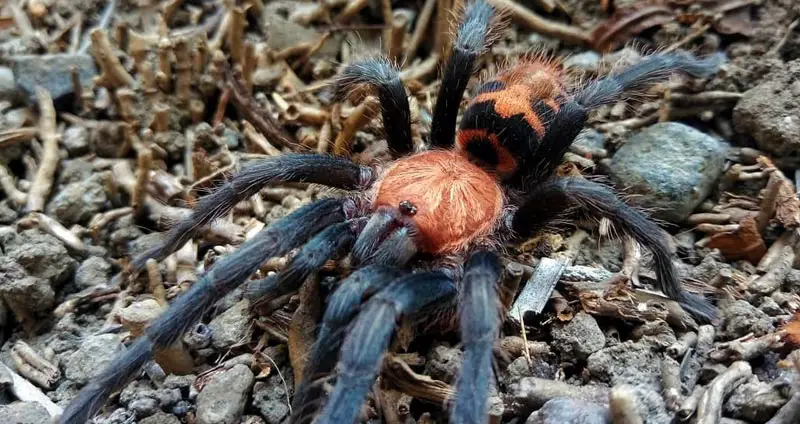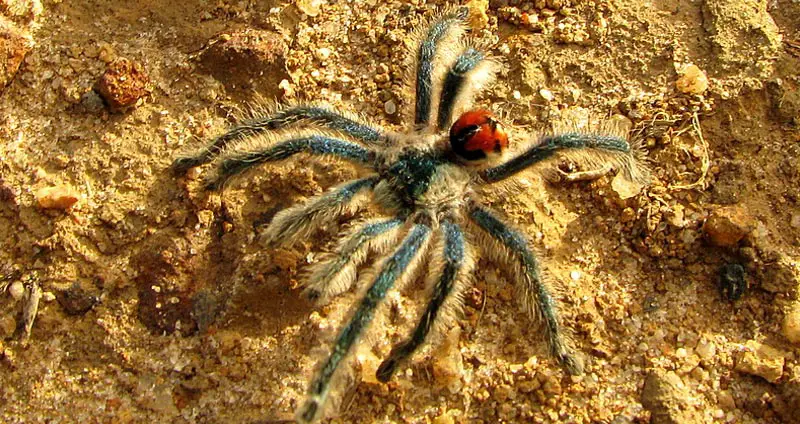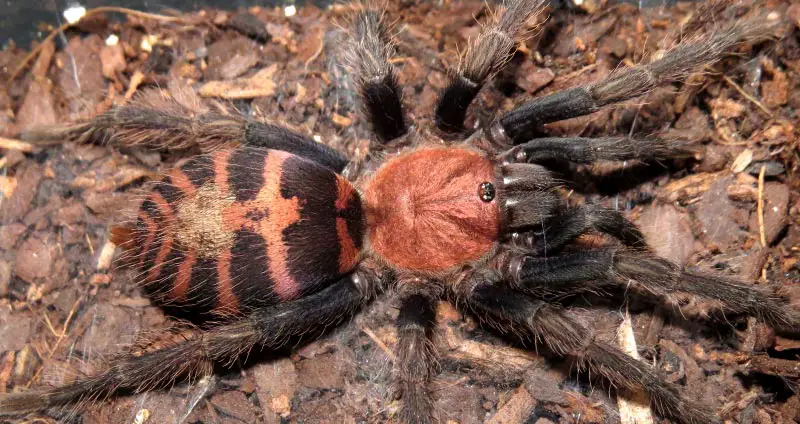Davus pentaloris, also known as the Guatemalan Tiger Rump tarantula, is a member of the Davus genus in the Theraphosidae family. It is native to the tropical rain forests in Guatemala and Mexico.
Their orange fur and tiger-striped pattern give them a distinguished place among the over 800 tarantula species in existence today. Despite being smaller than other bird spiders, Davus pentaloris are highly valued by tarantula enthusiasts.
Table of Contents
Davus pentaloris Care Sheet
| | |
Common Name |
Guatemalan Tiger Rump |
Species Type |
New world terrestrial |
Natural Habitat |
Found in Mexico and Guatemala. It lives in warm, temperate climates with 6 months of consecutive rain and plenty of brush protection. |
Growth Rate |
Fast growth rate. Their adult size is small, so they reach this size quite fast. |
Adult Size |
Females reach a legspan of about 4″, with males measuring slightly smaller. |
Lifespan |
Females tend to live up to 11 years, while males don’t live past 4. |
Enclosure |
The enclosure should be wider than it is tall with an emphasis on floor space. 4 inches of substrate should line the bottom of the enclosure. A hide and water dish should also be present. |
Temp/Humidity |
76°F to 80°F with about 80% humidity. |
Diet |
This tarantula doesn’t eat a lot, but it’s still a great eater. Can eat several adult-sized crickets per week. |
Temperament |
A very docile tarantula that calmly explores its enclosure. Rarely flicks hairs or throws up threat poses. |
Experience Level |
Beginner – A very beginner-friendly tarantula species without any special care caveats. |
Average Cost |
Slings ~ $35, Males ~ $80, Females ~ $120+ |
Davus pentaloris Appearance
D. pentaloris has a prominent appearance thanks to a brilliant copper carapace and striped abdomen that resembles a tiger’s stripes. There are slight variations in the coloration of their torsos, usually sporting dominant pinks that strongly contrast against their dark prissy hairs.
The abdomen and legs of the Davus pentaloris are completely covered in fine hairs, which are used as a defense mechanism against predators.
Compared to other tarantulas, D. pentaloris is quite small and will reach a maximum leg span of only 4 inches. Males appear even smaller due to their longer legs and smaller bodies.
Spiderlings start very small but retain a lot of their coloration and patterns, and they grow into adults at a decently fast rate. Female specimens live for up to 11 years, while males only live up to 4 years.


via @arachnochamber / Instagram
Davus pentaloris Temperament
This stunning tarantula comes with a great personality to match! D. pentaloris is a new world tarantula, which is a type of tarantula that’s known for its friendly disposition and preference to run away from danger as opposed to fighting it.
Due to this, you’ll often see this tarantula calmly walking around its enclosure, going about its day without a care in the world. However, it does possess irritating urticating hairs, so be cautious when feeding or attempting to handle your specimen.
Some owners report that their D. pentaloris will quickly run to cover whenever they enter their enclosure for feeding or cleaning. However, this doesn’t last long, as it absolutely loves to eat and has an excellent feeding response that’s very fun to watch.
In short, this is a middle-of-the-road tarantula species. It’s skittish and nervous, but it can be bold and exciting when it wants to. You never really know what you’re going to get!
Housing Davus pentaloris
The Guatemalan Tiger Rump tarantula does not have a lot of specific environmental needs. They’re very simple and small, meaning that providing an optimal enclosure is quite easy to do. It does, however, take some effort to put the enclosure together.
Optimal Davus pentaloris Enclosure
To begin with, this is a terrestrial tarantula that spends most of its time in burrows and on the ground, so its enclosure needs to have a large focus on floor space and depth. There should also be several anchor points for their webbing.
A terrestrial tarantula enclosure with dimensions of about 12″ x 12″ x 12″ is perfect for this dwarf species, like this one from Exo Terra. Spiderlings are able to be kept in smaller enclosures as they’re growing, but be sure that there’s proper ventilation and still enough room to move around!
The enclosure highlighted above has great cross-ventilation, accessibility, and security — all very important aspects of an enclosure.
Enclosure Decorations
The inside of the enclosure can’t be barren as these tarantulas require a few supplies for terrestrial species. Like most terrestrials, Davus pentaloris is an avid burrower and should not be deprived of this opportunity.
4-5 inches of moisture-retaining substrate layered on the ground allows them to burrow to their heart’s content.
The inclusion of a tarantula hide, such as a piece of cork bark, is essential to provide shelter and allow this skittish species to feel more secure. Fake plants also provide additional coverage.
Finally, a water bowl is absolutely essential. Tarantulas not only drink this water, but it also helps to keep the enclosure humid and comfortable.
Enclosure Humidity/Heating
This is a species that’s very moderate in its climate requirements. Of course, coming from South America, it’s going to be more accustomed to warm and humid climates. However, this warmth and humidity needs to be done correctly to allow for good health.
The substrate should be kept slightly damp at all times in order to keep humidity levels around 80%. When humidity levels start to drop, the substrate can be resprayed with water, and the water dish can be overfilled to dampen the substrate around it.
In terms of temperature, Davus pentaloris does best around 76°F to 80°F. This is close to room temperature for most people, so supplemental heating won’t be required. If your house dips below this range, though, you may need to provide supplemental heating through the use of a space heater.
You can easily monitor the temperature and humidity of the enclosure through a simple thermometer/hygrometer.
Diet
The Guatemalan Tiger Rump tarantula grows at a quick pace and will reach a size of two inches in a bit over a year. Newborn spiderlings thrive on flightless fruit flies, and they can transition to pinhead crickets once they reach 1/2″.
As adults, this tarantula can eat 4 adult crickets per week. If your tarantula is particularly hungry, it’s possible to increase feeding frequency.
It should also be noted that this is a cannibalistic tarantula species, so one may eat another if they’re kept communally! Quite spunky for such little guys.
Health Concerns
Captive tarantulas rarely experience any health problems. The most common problems that pet tarantulas face are dehydration and mite infestations. Both of these issues, though, are easily avoided and dealt with.
It should be noted that if your Davus pentaloris is kept in an enclosure that’s too warm/cold or too humid/dry, their health could severely suffer. It’s common for enclosures to become “swampy”, and this needs to be avoided.
Davus pentaloris For Sale & Price
These tarantulas aren’t too rare and expensive, so they’re quite accessible for anybody that’s interested in them.
They’re available on multiple online marketplaces for a variety of prices depending on age and sex. Slings sell for around $35, while mature females sell upwards of $120. For what this tarantula brings to the table, though, this isn’t a bad price at all!
If you’re looking for a tarantula with a very unique appearance, generally calm temperament, and fun personality, Davus pentaloris a very affordable and accessible option!


